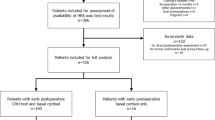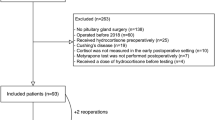Abstract
Purpose
Remission from Cushing disease (CD) after pituitary adenoma resection may be predicted by a postoperative reduction in serum cortisol level. A 2008 consensus statement recommends assessing morning cortisol levels during the first postoperative week, and replacing glucocorticoid (GC) if cortisol nadir of < 2 or < 5 µg/dL is achieved. We sought to evaluate adherence to consensus recommendations following adrenocorticotropic hormone (ACTH)-secreting pituitary adenoma resection at our tertiary medical center, and assess time to cortisol nadir to better define the window for assessment and intervention.
Methods
We retrospectively analyzed data extracted from in-hospital electronic medical records for CD surgeries between January 1991 and September 2015. We compared cortisol levels and collection times, ACTH measurement, and postoperative and discharge GC treatment before and after consensus statement publication in July 2008.
Results
107 surgeries were performed in 92 patients with CD. After 2008, more surgeries had at least one cortisol value assessed (67.9% before vs. 91.3% after, p = 0.033), with median initial cortisol measurement at 14 h post-surgery. However, ACTH measurement remained unchanged (42.9% vs. 43.5%; p > 0.99). Cortisol collection during GC treatment tended to increase (32.7% vs. 57.1%; p = 0.068). Of surgeries performed without prior GC treatment, 31.7 and 55.0% had a cortisol nadir of < 2 and < 5 µg/dL, respectively, within 72 h postoperative.
Conclusions
Our physicians were more diligent in measuring in-hospital postoperative cortisol levels consistent with 2008 consensus recommendations. Better management of cortisol measurements and their timing is an opportunity for improvement.



Similar content being viewed by others
References
Krikorian A, Abdelmannan D, Selman WR, Arafah BM (2007) Cushing disease: use of perioperative serum cortisol measurements in early determination of success following pituitary surgery. Neurosurg Focus 23(3):E6. doi:10.3171/foc.2007.23.3.8
Nieman LK, Biller BM, Findling JW, Murad MH, Newell-Price J, Savage MO, Tabarin A, Endocrine S (2015) Treatment of Cushing’s syndrome: an endocrine society clinical practice guideline. J Clin Endocrinol Metab 100(8):2807–2831. doi:10.1210/jc.2015-1818
Biller BM, Grossman AB, Stewart PM, Melmed S, Bertagna X, Bertherat J, Buchfelder M, Colao A, Hermus AR, Hofland LJ, Klibanski A, Lacroix A, Lindsay JR, Newell-Price J, Nieman LK, Petersenn S, Sonino N, Stalla GK, Swearingen B, Vance ML, Wass JA, Boscaro M (2008) Treatment of adrenocorticotropin-dependent Cushing’s syndrome: a consensus statement. J Clin Endocrinol Metab 93(7):2454–2462. doi:10.1210/jc.2007-2734
Dallapiazza RF, Oldfield EH, Jane JA Jr (2015) Surgical management of Cushing’s disease. Pituitary 18(2):211–216. doi:10.1007/s11102-015-0646-5
AbdelMannan D, Selman WR, Arafah BM (2010) Peri-operative management of Cushing’s disease. Rev Endocr Metab Disord 11(2):127–134. doi:10.1007/s11154-010-9140-6
Esposito F, Dusick JR, Cohan P, Moftakhar P, McArthur D, Wang C, Swerdloff RS, Kelly DF (2006) Clinical review: early morning cortisol levels as a predictor of remission after transsphenoidal surgery for Cushing’s disease. J Clin Endocrinol Metab 91(1):7–13. doi:10.1210/jc.2005-1204
Shimon I, Ram Z, Cohen ZR, Hadani M (2002) Transsphenoidal surgery for Cushing’s disease: endocrinological follow-up monitoring of 82 patients. Neurosurgery 51(1):57–61
Fleseriu M, Hamrahian AH, Hoffman AR, Kelly DF, Katznelson L, Neuroendocrine A (2016) Pituitary Scientific Committee: American Association of Clinical Endocrinologists and American College of Endocrinology disease state clinical review: diagnosis of recurrence in cushing disease. Endocr Pract 22(12):1436–1448. doi:10.4158/EP161512.DSCR
Etxabe J, Vazquez JA (1994) Morbidity and mortality in Cushing’s disease: an epidemiological approach. Clin Endocrinol 40(4):479–484
Lindholm J, Juul S, Jorgensen JO, Astrup J, Bjerre P, Feldt-Rasmussen U, Hagen C, Jorgensen J, Kosteljanetz M, Kristensen L, Laurberg P, Schmidt K, Weeke J (2001) Incidence and late prognosis of cushing’s syndrome: a population-based study. J Clin Endocrinol Metab 86(1):117–123. doi:10.1210/jcem.86.1.7093
Bansal V, Asmar El, Selman N, Arafah WR (2015) B.M.: Pitfalls in the diagnosis and management of Cushing’s syndrome. Neurosurg Focus 38(2):E4. doi:10.3171/2014.11.FOCUS14704
Pouratian N, Prevedello DM, Jagannathan J, Lopes MB, Vance ML, Laws ER Jr (2007) Outcomes and management of patients with Cushing’s disease without pathological confirmation of tumor resection after transsphenoidal surgery. J Clin Endocrinol Metab 92(9):3383–3388. doi:10.1210/jc.2007-0208
Mamelak AN, Carmichael J, Bonert VH, Cooper O, Melmed S (2013) Single-surgeon fully endoscopic endonasal transsphenoidal surgery: outcomes in three-hundred consecutive cases. Pituitary 16(3):393–401. doi:10.1007/s11102-012-0437-1
Refetoff S, Van Cauter E, Fang VS, Laderman C, Graybeal ML, Landau RL (1985) The effect of dexamethasone on the 24-hour profiles of adrenocorticotropin and cortisol in Cushing’s syndrome. J Clin Endocrinol Metab 60(3):527–535. doi:10.1210/jcem-60-3-527
Rittmaster RS, Loriaux DL, Cutler GB Jr (1985) Sensitivity of cortisol and adrenal androgens to dexamethasone suppression in hirsute women. J Clin Endocrinol Metab 61(3):462–466. doi:10.1210/jcem-61-3-462
Krasowski MD, Drees D, Morris CS, Maakestad J, Blau JL, Ekins S (2014) Cross-reactivity of steroid hormone immunoassays: clinical significance and two-dimensional molecular similarity prediction. BMC Clin Pathol 14:33. doi:10.1186/1472-6890-14-33
Dietrich J, Rao K, Pastorino S, Kesari S (2011) Corticosteroids in brain cancer patients: benefits and pitfalls. Expert Rev Clin Pharmacol 4(2):233–242. doi:10.1586/ecp.11.1
Abdelmannan D, Chaiban J, Selman WR, Arafah BM (2013) Recurrences of ACTH-secreting adenomas after pituitary adenomectomy can be accurately predicted by perioperative measurements of plasma ACTH levels. J Clin Endocrinol Metab 98(4):1458–1465. doi:10.1210/jc.2012-3910
Salmon PM, Loftus PD, Dodd RL, Harsh G, Chu OS, Katznelson L (2014) Utility of adrenocorticotropic hormone in assessing the response to transsphenoidal surgery for Cushing’s disease. Endocr Pract 20(11):1159–1164. doi:10.4158/EP14140.OR
Debono M, Ross RJ, Newell-Price J (2009) Inadequacies of glucocorticoid replacement and improvements by physiological circadian therapy. Eur J Endocrinol 160(5):719–729. doi:10.1530/EJE-08-0874
Acknowledgements
We thank Ms. Shira Berman for her help in editing this manuscript.
Author information
Authors and Affiliations
Corresponding author
Ethics declarations
Disclosures
The authors declare that they have no conflict of interest.
Ethical approval
All procedures performed in studies involving human participants were in accordance with the ethical standards of the institutional and/or national research committee and with the 1964 Helsinki declaration and its later amendments or comparable ethical standards.
Informed consent
For this type of study formal consent is not required.
Rights and permissions
About this article
Cite this article
Stolyarov, Y., Mirocha, J., Mamelak, A.N. et al. Consensus-driven in-hospital cortisol assessment after ACTH-secreting pituitary adenoma resection. Pituitary 21, 41–49 (2018). https://doi.org/10.1007/s11102-017-0845-3
Published:
Issue Date:
DOI: https://doi.org/10.1007/s11102-017-0845-3




